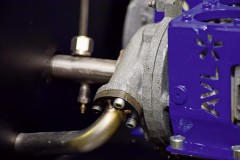The mobile generators used for air conditioning and to power electrical appliances in long-range goods vehicles, caravans or boats when these are stationary, feature internal-combustion engines that drive a generator. With their low ratings these small engines are very inefficient and involve rather a lot of noise and pollution.
In collaboration with research partners (Institute of Lightweight Design and Institute of Thermal Engineering at Graz University of Technology) AVL LIST GMBH has developed a Solid Oxide Fuel Cell Auxiliary Power Unit (SOFC APU): a fuel cell generator for mobile applications which converts pretty well any fuel, e.g. synthetic methane, bioethanol, biomethanol, into electricity with remarkable efficiency, free of pollution and with little noise. The current system runs on ordinary diesel fuel, but consumes only half as much fuel as a diesel engine for a given amount of electricity.
First the fuel goes to a catalytic reformer, which converts the fuel completely into a syngas containing hydrogen. This gas is then fed into the actual fuel cell, where an electrochemical reaction between hydrogen and carbon monoxide generates electricity.
Pioneering SOFC APU system
Within ASys I an entirely stand-alone 2-3 kW SOFC APU system was set up with new components, successfully operated for 1,000 hours and subjected to intensive analysis (inter alia in a vibration test). At the same time a reliability study analysed and modelled dominant error mechanisms; accelerated test procedures were derived from this. Overall, the project team made remarkable technical progress toward competitive SOFC APU systems, achieving all the targets set: a power rating of 2 kW, an efficiency factor of 30 % and a noise level below 55 dB (A).
The complete AVL SOFC APU system is a compact integrated unit, small and light, with a volume of 80 l and weighing 70 kg. As part of the project a vehicle integration strategy was worked out, and a control unit for automated system operation developed, together with partners in the US commercial vehicle industry. The packaging concept for the first-generation SOFC APU involves installing two SOFC stacks, making ratings up to 4 kW attainable even at this early stage.
Excellent results
The fuel cell generator can reduce commercial vehicles‘ diesel consumption and carbon dioxide emissions when idling by up to 60 %. The project won the Province of Styria‘s Innovation Prize “Fast Forward Award 2012”, and was nominated for the Austrian State Prize “Innovation 2013”.
In the follow-up project ASys II the focus will be on increasing service life, with the aim of reaching a service life of more than 5,000 hours for hydrocarbon-based SOFC systems. To this end the basic processes by which damage occurs while an SOFC system is running on a hydrocarbon-based fuel are to be investigated. At the same time extensive validation tests are to be carried out, so as to learn more about environmental and detrimental influences during actual operation.

